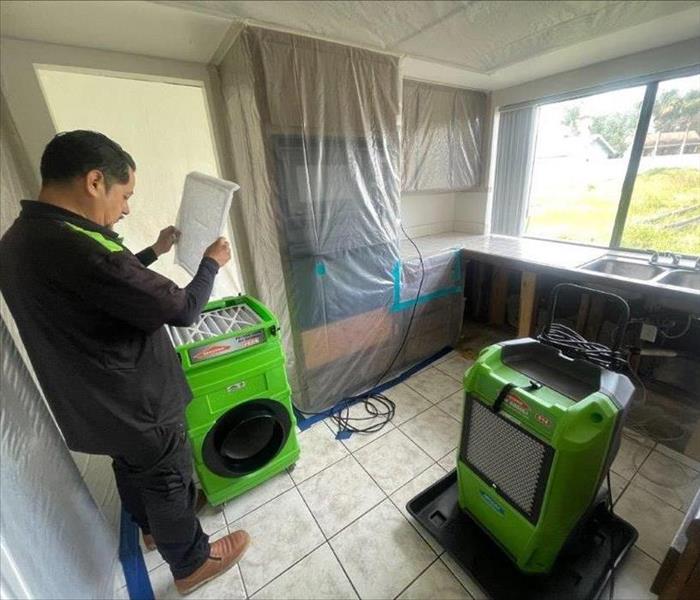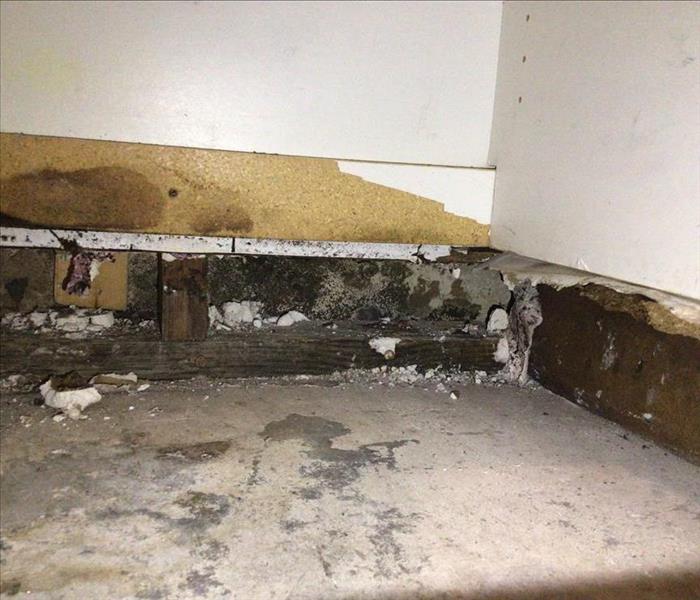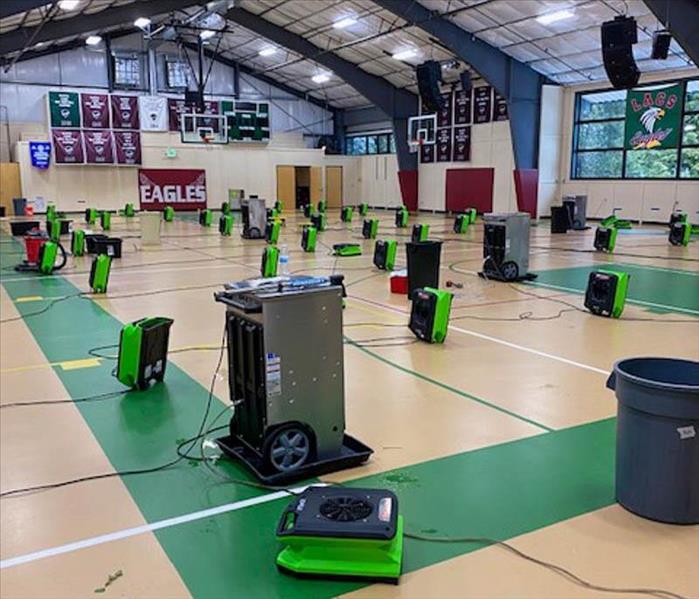Recent Posts
Pets and Mold: Protecting Your Furry Friend
7/17/2024 (Permalink)
As pet owners, we know how important it is to keep our furry friends safe and comfortable. One often overlooked threat to their well-being is mold. Mold can grow in any home and thrive in damp, humid environments, posing a risk to our pets. At SERVPRO®, we understand the importance of maintaining a mold-free home, not just for your family but also for your pets. Here are some tips and insights on how to protect your furry friends from mold.
Understanding Mold Growth
Mold spores are everywhere, but they only become a problem when they find a suitable environment to grow. Moisture is the key ingredient for mold growth. Common places where mold can develop include basements, bathrooms, kitchens, and areas around leaky windows or roofs. Mold can also thrive in pet areas, such as near water bowls, in aquariums, or in spaces where pets might have accidents.
Preventing Mold in Pet Areas
- Keep Pet Areas Dry: Ensure that any areas where your pets spend time are kept dry and well-ventilated. This includes spaces where they eat, sleep, and play. Use a dehumidifier in damp areas and fix any leaks promptly to prevent moisture buildup.
- Regular Cleaning: Regularly clean your pet’s bedding, toys, and feeding areas. Use washable materials for pet beds and blankets, and wash them frequently in hot water to kill any mold spores.
- Control Humidity: Keep indoor humidity levels below 60% by using air conditioners or dehumidifiers. You can also use exhaust fans in bathrooms and kitchens to reduce moisture.
- Aquarium Care: If you have an aquarium, ensure it is properly maintained. Regularly clean the tank and ensure it has a good filtration system to prevent mold growth.
Detecting Mold Early
It's essential to detect mold early to prevent it from spreading. Look for visible signs of mold, such as black or green spots on walls, ceilings, or floors. Mold can also have a musty odor, which can be a telltale sign of its presence. If you suspect mold, it’s crucial to address it immediately.
Professional Mold Remediation
While small mold issues can sometimes be handled with proper cleaning, larger mold problems require professional intervention. SERVPRO offers expert mold remediation services to ensure your home is thoroughly cleaned and safe for both your family and pets. Our team uses advanced equipment and techniques to detect and eliminate mold, ensuring it doesn’t return.
Creating a Mold-Free Environment
Maintaining a mold-free environment is a continuous process. Regular home inspections, proper ventilation, and immediate attention to moisture issues are key steps in preventing mold growth. By taking these proactive measures, you can protect your pets from the risks associated with mold and ensure they remain happy and healthy in a safe home environment.
Your pets rely on you for their safety and comfort. By understanding the risks of mold and taking steps to prevent its growth, you can create a healthier living space for your furry friends. Remember, if you ever encounter a mold problem that's too big to handle on your own, SERVPRO is here to help with professional mold remediation services. Together, we can ensure a mold-free home for you and your pets.
The Importance of Prompt Water Damage Restoration
6/11/2024 (Permalink)
 Prompt water damage restoration is crucial for minimizing property damage and preventing mold growth.
Prompt water damage restoration is crucial for minimizing property damage and preventing mold growth.
Water damage can wreak havoc on your property, and the aftermath can be overwhelming. Whether it's from burst pipes, leaky appliances, or natural disasters, the key to minimizing damage is taking swift action. Timely water damage restoration is essential to prevent further deterioration of your property and mitigate potential health hazards.
Understanding the Importance of Timely Restoration
When water damage occurs, it's crucial to address the situation promptly. Delaying restoration efforts can lead to secondary issues such as mold growth, structural damage, and compromised indoor air quality. Mold can begin to develop within 24 to 48 hours after water exposure, posing risks to occupants and worsening property damage. Additionally, prolonged exposure to moisture can weaken building materials and compromise the integrity of your home or business.
Immediate Action Steps
Upon discovering water damage, take immediate action to mitigate further damage. Start by shutting off the main water supply to prevent additional water from entering your property. If safe to do so, unplug electrical appliances and turn off the power supply to avoid electrical hazards. Remove excess water using towels, mops, or wet vacuums, and open windows and doors to facilitate airflow and expedite the drying process.
Contacting Water Damage Restoration Professionals
While DIY cleanup efforts can be tempting, enlisting the expertise of water damage restoration professionals is highly recommended. Experienced technicians have the knowledge, skills, and specialized equipment to assess the extent of the damage and implement effective restoration strategies. They can identify hidden moisture pockets, thoroughly dry affected areas, and sanitize surfaces to prevent mold growth and bacterial contamination.
Comprehensive Assessment and Restoration
Upon arrival, restoration professionals will conduct a comprehensive assessment of the property to determine the best course of action. This may involve extracting standing water, removing damaged materials, and implementing drying techniques such as dehumidification and air circulation. Advanced moisture detection tools, such as infrared cameras and hygrometers, are used to identify moisture infiltration in walls, floors, and ceilings.
Monitoring and Follow-Up
Throughout the restoration process, technicians monitor moisture levels to ensure that affected areas are thoroughly dried and sanitized. Once the restoration is complete, they perform a final inspection to verify that all water damage has been addressed and that the property is safe for occupancy. Additionally, reputable restoration companies provide documentation of the restoration process, including photographs, moisture readings, and itemized invoices, to assist with insurance claims.
Prompt water damage restoration is crucial for minimizing property damage, preventing mold growth, and protecting indoor air quality. By taking immediate action and enlisting the help of qualified professionals, you can mitigate the impact of water damage and restore your property to its preloss condition. Don't delay—contact a trusted water damage restoration company, such as SERVPRO of South Redlands/Yucaipa/North Riverside City at the first sign of water intrusion to ensure a swift and effective restoration process.
10 Signs of Water Damage After a Storm
5/15/2024 (Permalink)
 If you notice any of these signs of water damage after a storm or weather event, it's important to act quickly.
If you notice any of these signs of water damage after a storm or weather event, it's important to act quickly.
After a storm or severe weather event, it's crucial to inspect your property for signs of water damage. Detecting water damage early can prevent further deterioration and costly repairs. Here are some key signs to look out for:
Water Stains
Water stains on walls, ceilings, or floors are telltale signs of water intrusion. These stains may appear discolored, darker, or even moldy, indicating prolonged exposure to moisture.
Musty Odors
A musty or moldy smell in your home, especially in areas prone to moisture, could indicate the presence of hidden water damage. Mold thrives in damp environments and can quickly develop after water intrusion.
Warped or Buckled Flooring
Excess moisture can cause wooden flooring to warp or buckle. If you notice any unevenness or lifting of floorboards, it could be a sign of water damage underneath.
Peeling Paint or Wallpaper
Water seeping into walls can cause paint or wallpaper to peel, bubble, or blister. These cosmetic issues are often indicative of underlying water damage that requires immediate attention.
Sagging Ceilings or Walls
Prolonged exposure to water can weaken the structural integrity of ceilings and walls, causing them to sag or bulge. This is a serious sign of water damage that should be addressed promptly to prevent further structural issues.
Mold Growth
Visible mold growth on walls, ceilings, or other surfaces is a clear indication of water damage. Mold thrives in moist environments and can pose health risks to occupants if left unchecked.
Dampness or Moisture
Feeling dampness or moisture in areas where it shouldn't be, such as carpets, walls, or furniture, suggests water infiltration. Use a moisture meter to detect hidden moisture in building materials.
Water Pooling
Puddles of water or standing water in basements, crawl spaces, or around the foundation of your home indicate poor drainage or water intrusion from outside.
Cracks in Walls or Foundation
Excessive water pressure from heavy rainfall or flooding can cause cracks to form in walls, floors, or the foundation of your home. These cracks allow water to seep in and cause further damage if not addressed promptly.
Increased Utility Bills
A sudden spike in water bills without any corresponding increase in usage could indicate a hidden water leak or other water-related issues within your home.
If you notice any of these signs of water damage after a storm or weather event, it's important to act quickly. Contacting a professional water damage restoration company like SERVPRO® can help mitigate further damage and restore your home to its preloss condition. Don't delay addressing water damage, as prompt action can save you time, money, and stress in the long run.
7 Tips to Keep Your Commercial Kitchen Safe
4/17/2024 (Permalink)
 If you are in need of commercial fire damage cleanup and restoration, don't hesitate and give us a call!
If you are in need of commercial fire damage cleanup and restoration, don't hesitate and give us a call!
In a busy commercial kitchen, safety should always be a top priority. One of the most significant risks in any kitchen environment is the potential for fires, which can result in property damage, business interruption, and even personal injury. To protect your employees, customers, and property, it's essential to implement proactive measures to prevent fires. In this blog post, we'll explore practical tips to help you prevent commercial kitchen fires and maintain a safe working environment.
1. Invest in Quality Equipment
Investing in high-quality kitchen equipment can significantly reduce the risk of fires. Ensure that all appliances, such as stoves, ovens, and deep fryers, are well-maintained and in good working condition. Regularly inspect and service equipment to address any potential issues before they escalate into safety hazards.
2. Practice Proper Ventilation
Adequate ventilation is crucial for removing heat, smoke, and grease from the kitchen environment. Install and maintain exhaust hoods, ductwork, and fans to ensure proper ventilation throughout the kitchen. Regularly clean and inspect ventilation systems to prevent grease buildup, which can pose a fire risk.
3. Train Your Staff
Proper training is key to preventing kitchen fires. Ensure that all kitchen staff receive comprehensive training on fire safety protocols, including how to use fire extinguishers, respond to emergencies, and safely operate kitchen equipment. Regularly conduct fire drills to reinforce safety procedures and ensure that all employees know how to respond in the event of a fire.
4. Maintain a Clean Workspace
A clean and organized kitchen is less likely to experience fires. Implement strict cleaning protocols to keep surfaces, appliances, and exhaust systems free of grease, oil, and other flammable materials. Regularly clean and degrease cooking equipment, countertops, and floors to minimize fire hazards.
5. Monitor Cooking Processes
Keep a close eye on cooking processes at all times to prevent overheating and potential fire hazards. Avoid leaving cooking appliances unattended, and use timers to remind staff to check on food regularly. Train employees to recognize warning signs of potential fire hazards, such as smoke, unusual odors, or excessive heat.
6. Install Fire Suppression Systems
Installing automatic fire suppression systems, such as sprinklers or fire blankets, can provide an additional layer of protection against kitchen fires. These systems can quickly extinguish small fires before they escalate, minimizing damage and preventing injuries.
7. Regular Inspections and Maintenance
Conduct regular inspections and maintenance checks to identify and address potential fire hazards in the kitchen. Inspect electrical systems, gas lines, and cooking equipment for signs of wear or damage, and promptly repair or replace any faulty components.
By implementing these proactive measures, you can significantly reduce the risk of fires in your commercial kitchen and create a safer working environment for your employees. Prioritize fire safety training, maintain proper ventilation and cleanliness, and invest in quality equipment and fire suppression systems to protect your business from the devastating effects of kitchen fires. If a fire does occur, remember to evacuate the premises immediately and contact emergency services for assistance.
A Guide to Removing Mold from Home Insulation
3/12/2024 (Permalink)
 In this blog, we'll provide you with a practical guide on how to effectively remove mold from home insulation without unnecessary fuss.
In this blog, we'll provide you with a practical guide on how to effectively remove mold from home insulation without unnecessary fuss.
Discovering mold in your home insulation can be a cause for concern, but rest assured, addressing the issue is a manageable task. Mold in insulation often occurs in areas with high humidity or water damage, and taking prompt action is crucial. In this blog, we'll provide you with a practical guide on how to effectively remove mold from home insulation without unnecessary fuss.
1. Identify the Affected Area
Begin by identifying the areas of insulation that show signs of mold growth. Look for discoloration, a musty odor, or visible mold patches on the insulation material.
2. Gather Your Supplies
Before diving into the removal process, gather the necessary supplies. You'll need protective gear such as gloves, a mask, and safety glasses. Additionally, have garbage bags, a vacuum cleaner with a HEPA filter, and a stiff brush or sponge ready.
3. Isolate the Area
To prevent the spread of mold spores to other parts of your home, isolate the affected area. Seal off the space with plastic sheeting and tape, creating a containment zone for the removal process.
4. Remove and Discard Moldy Insulation
Carefully remove the mold-affected insulation from the area. Place the insulation directly into garbage bags, sealing them tightly. This ensures that mold spores are contained and don't spread during disposal.
5. Clean the Area
Thoroughly clean the area from which you removed the insulation. Use a stiff brush or sponge along with appropriate cleaning products to scrub the surfaces. This helps remove any remaining mold spores or residues.
6. Vacuum with HEPA Filter
Use a vacuum cleaner equipped with a HEPA filter to carefully vacuum the entire space, including the floor and surrounding surfaces. This helps capture and trap any airborne mold spores, preventing them from spreading.
7. Replace with Mold-Resistant Insulation
After completing the cleaning process, it's time to replace the removed insulation. Consider using mold-resistant insulation materials to minimize the risk of future mold growth. This is particularly important in areas prone to moisture.
8. Address the Source of Moisture
To prevent mold from returning, identify and address the source of moisture. Whether it's a leak, water intrusion, or high humidity, resolving the underlying issue is crucial for long-term mold prevention.
9. Monitor for Recurrence
Keep an eye on the treated area for any signs of mold recurrence. Regular inspections and maintaining a dry environment will help ensure that your efforts in mold removal and prevention are effective.
By following these practical steps, you can successfully remove mold from home insulation and create a healthier indoor environment. Remember, a proactive approach and addressing moisture issues are key to keeping mold at bay.
Danger/Personal Risks Associated with Standing Water in Homes: A Word of Caution
2/4/2024 (Permalink)
Standing water can pose significant risks to both the structure of a home and safety of its occupants. Understanding the potential dangers and personal risks associated with standing water is crucial for homeowners to take immediate action to mitigate these hazards. In this blog post, we will explore the various dangers of standing water in homes and the importance of addressing them promptly.
Electrical Hazards
One of the most dangerous risks associated with standing water is the potential for electrical hazards. When water comes into contact with electrical outlets, appliances, or wiring, it can cause electric shocks, fires, and even electrocution. Homeowners should never enter standing water without first ensuring that the power is shut off to affected areas and should avoid using electrical equipment near water where the power source may not be adequately protected.
Slip and Fall Accidents
Standing water creates a slippery surface, increasing the risk of slip and fall accidents. The wet surfaces can make it challenging to maintain balance, leading to injuries such as sprained ankles, fractured bones, or head trauma. Prompt removal of standing water using appropriate extraction methods should be a priority to eliminate the risk of slip and fall accidents in the home.
Mold Growth and Allergens
Standing water creates a perfect environment for the growth of mold and other allergies. It is essential to address standing water promptly to prevent mold growth and ensure a healthy living environment for everyone in the home. Professional mold remediation may be necessary to thoroughly eliminate mold and prevent its return.
Pest Infestation
Standing water attracts pests, such as mosquitoes, flies, and rodents, that thrive in moist environments. Mosquitoes, in particular, can carry diseases such as West Nile virus or Zika virus. Additionally, rodents seeking water and shelter may enter the home, causing damage to property and spreading diseases. Removing standing water and addressing any entry points or conducive conditions for pests is crucial to prevent infestations and protect the well-being of the household.
Structural Damage
Prolonged exposure to standing water can cause significant structural damage to a home. Water can weaken building materials, such as wood or drywall, leading to rot, warping, and compromised structural integrity. This can result in costly repairs and potentially unsafe living conditions. Timely water extraction, drying, and restoration are essential to prevent further damage to the home's structure.
Standing water in homes presents numerous dangers and personal risks, ranging from electrical hazards and slip and fall accidents to contamination and structural damage. Homeowners should never underestimate the potential risks associated with standing water and must take immediate measures to address the issue through water extraction, drying, disinfection, and professional restoration to safeguard both their property and the well-being of their family.
Emergency Preparedness: Creating a Storm Survival Kit for Any Situation
1/3/2024 (Permalink)
When a storm strikes, being prepared can make a significant difference in your safety and well-being. One essential step in emergency preparedness is creating a storm survival kit. In this blog, we will guide you through the process of building a comprehensive kit that includes essential supplies and resources to help you weather any storm situation.
Water and Food Supplies
An ample supply of water is crucial during emergencies. Store at least one gallon of water per person per day for a minimum of three days. Non-perishable food items such as canned goods, granola bars, and dried fruits should also be included. Don't forget a manual can opener and any necessary utensils for eating.
First Aid Kit and Medications
A well-stocked first aid kit is essential for treating minor injuries and providing immediate medical assistance. Make sure your kit includes bandages, antiseptic solution, pain relievers, any necessary prescription medications, and a manual or battery-operated thermometer.
Communication and Lighting
In the event of a power outage, reliable communication and lighting tools are invaluable. Include a battery-powered or hand-crank radio to receive updates and stay informed. Have extra batteries or consider purchasing a solar-powered charger. Flashlights, candles, and matches should also be included to provide lighting when needed.
Personal Hygiene and Sanitation
Maintaining personal hygiene and sanitation during a storm is crucial for preventing the spread of illness. Include items such as hand sanitizers, baby wipes, toilet paper, and garbage bags. Don't forget essential hygiene products such as toothbrushes, toothpaste, soap, and feminine hygiene products.
Extra Clothing and Bedding
Having extra clothing and bedding can provide comfort and warmth during extended periods of power outage. Pack warm blankets, extra clothing layers, rain gear, sturdy shoes, and socks. Consider the climate and weather conditions specific to your area and adjust your clothing choices accordingly.
Cash and Important Documents
It is important to have some cash on hand in case ATMs or credit card machines are not operational during a storm. Keep a small amount of cash in your survival kit. Additionally, include copies of important documents such as identification documents, insurance policies, and contact information for emergency contacts.
Tailor your survival kit to meet the specific needs of your household. Consider including additional items such as a whistle, multi-tool, duct tape, extra batteries, a fire extinguisher, a map of your area, and any personal or unique items that may be necessary for your family's well-being.
Creating a storm survival kit is an essential step in emergency preparedness. By including water and food supplies, a first aid kit, communication and lighting tools, personal hygiene items, extra clothing and bedding, cash and important documents, and any necessary additional items, you can ensure your readiness for any storm situation. Stay safe and be prepared!
The Importance of Cleaning Your Dryer Vents to Prevent a Fire
12/20/2023 (Permalink)
We often think of our homes as safe havens, but did you know that a simple household appliance could pose a hidden fire hazard? Your clothes dryer, a daily convenience, can become a potential danger if not properly maintained. In this blog, SERVPRO® highlights the critical importance of cleaning dryer vents to prevent fires and protect your home and loved ones.
The Hidden Danger
Lint, the tiny fibers that accumulate in your dryer, may seem harmless, but it's highly combustible. When lint builds up in your dryer vents, it creates a dangerous situation. Here's why:
Increased Fire Risk
Lint buildup restricts the airflow in the dryer exhaust system, causing the dryer to overheat. Excessive heat, in combination with lint, can ignite and lead to a dangerous fire. According to the National Fire Protection Association (NFPA), dryers account for an estimated 15,970 home fires annually.
Carbon Monoxide Poisoning
Blocked dryer vents can also release carbon monoxide into your home. This colorless, odorless gas can be lethal if inhaled in large quantities. Protect your family's health by ensuring proper ventilation.
Preventative Measures
Preventing dryer fires is not only possible but also relatively simple. Here's what you can do:
Regular Cleaning
Regularly clean the lint trap in your dryer after each use. This simple step can significantly reduce lint buildup and fire risks.
Cleaning Dryer Vents
Cleaning the entire dryer vent system, from the lint trap to the exterior vent, is crucial. For this, consider enlisting the help of professionals who have the expertise and specialized equipment to ensure a thorough cleaning.
Signs of Trouble
Be vigilant for signs that your dryer vent may be clogged, as early detection is key to preventing potential hazards. If you notice that your clothes are taking longer than usual to dry, it could indicate restricted airflow due to lint buildup. Additionally, if your dryer becomes excessively hot during operation or if you detect a burning smell in the laundry area, these are clear red flags that demand immediate attention. Ignoring these warning signs may increase the risk of a dryer fire, so it's essential to address them promptly to ensure the safety of your home and loved ones.
Annual Inspection
Make it a practice to have your dryer vent inspected and cleaned by experts at least once a year. This ensures your appliance functions efficiently and safely.
Why Choose SERVPRO®?
With years of experience and certified technicians, our team provides 24/7 availability to respond swiftly to fire-related disasters. Our comprehensive services cover everything from assessing the extent of the damage to smoke and soot removal, structural repairs, and odor elimination. Utilizing advanced equipment and technology, we ensure a thorough and efficient recovery process, ultimately restoring your property to its pre-fire condition and providing you with peace of mind. Contact our SERVPRO® of SERVPRO® of South Redlands/Yucaipa/North Riverside City/Big Bear team to rebuild after a fire and experience professional, reliable, and customer-focused service.
Your home's safety should always be a top priority. By understanding the significance of cleaning dryer vents to prevent fires, you can protect your loved ones and your property. Remember, regular maintenance and professional assistance are key to ensuring that your dryer operates safely and efficiently.
Mold Prevention Strategies for Seasonal Properties: Keeping Your Vacation Home Mold-Free
11/7/2023 (Permalink)
Vacation homes provide a much-needed escape for relaxation and enjoyment, but they can also be susceptible to mold growth, particularly during periods of vacancy. In this blog, we will explore practical strategies for preventing mold in seasonal properties, ensuring a worry-free and pleasant experience.
Moisture Control
One of the key factors contributing to mold growth is excessive moisture. Before closing up your vacation home, thoroughly inspect and repair any leaks or water damage. Properly seal windows and doors to prevent water intrusion during heavy rains or storms. Consider using a dehumidifier or installing a programmable thermostat to maintain optimal humidity levels while the property is unoccupied.
Ventilation
Proper ventilation is vital in preventing mold growth in seasonal properties. Ensure that your vacation home has adequate airflow by opening windows or utilizing exhaust fans. Consider installing a mechanical ventilation system or a timer-controlled fan to promote air circulation and prevent condensation in enclosed spaces.
Regular Inspections
Routine inspections are crucial for detecting and addressing potential mold issues before they become major problems. Schedule periodic visits to your vacation home to inspect for signs of water leaks, musty odors, or visible mold growth. Pay extra attention to areas prone to moisture accumulation, such as basements, bathrooms, and kitchens. Promptly address any signs of moisture or mold to prevent further spread.
Furniture and Belongings Storage
Proper storage of furniture and belongings can help prevent mold growth during the off-season. Before closing up your vacation home, thoroughly clean and dry all items. Remove cushions, mattresses, and upholstery, allowing them to breathe and avoiding potential moisture retention. Consider using moisture-absorbing products, such as silica gel packs or desiccant bags, to help control humidity levels within storage areas.
Professional Assistance
In some cases, seeking professional assistance may be necessary to prevent and address mold issues in your seasonal property. Certified mold inspectors can provide thorough assessments, identifying moisture sources and recommending preventive measures. Mold remediation professionals can effectively remove mold and provide guidance on long-term prevention strategies.
Protecting your vacation home from mold growth requires proper moisture control, ventilation, regular inspections, and careful storage of belongings. By implementing these preventive strategies, you can ensure that your seasonal property remains mold-free, providing you and your loved ones with a safe and enjoyable retreat away from home.
Drying Techniques Used During Water Damage Mitigation
10/10/2023 (Permalink)
 Understanding the drying techniques and equipment used is essential for efficient and thorough recovery.
Understanding the drying techniques and equipment used is essential for efficient and thorough recovery.
When it comes to water damage restoration, understanding the drying techniques and equipment used is essential for efficient and thorough recovery. In this blog, we'll delve into the world of drying techniques, including the use of air movers, dehumidifiers, and more, to help you better protect your home and property.
Air Movers
Air movers, also known as industrial fans or blowers, are a crucial tool in the water damage restoration process. These powerful devices generate high-velocity airflow, which helps accelerate the drying of wet surfaces. Here’s why air movers are a standard go-to in the industry:
Even Air Distribution: Properly positioned air movers ensure even air distribution, preventing pockets of moisture from lingering in your home.
Speedy Drying: The continuous flow of air helps evaporate moisture from various surfaces, including walls, carpets, and hardwood floors.
Preventing Mold Growth: Timely use of air movers reduces the risk of mold growth, which can be a common consequence of water damage.
Dehumidifiers
Dehumidifiers play a vital role in maintaining the moisture balance within your home. Here's why they are indispensable in water damage restoration:
Humidity Control: Dehumidifiers remove excess moisture from the air, preventing condensation on surfaces and further damage.
Efficient Drying: Pairing dehumidifiers with air movers accelerates the drying process, ensuring thorough and efficient results.
Improved Indoor Air Quality: Dehumidifiers help maintain a healthy indoor environment by reducing humidity levels, discouraging mold growth, and preventing musty odors.
Moisture Meters
Professionals use moisture meters to measure the moisture content of various materials. This allows them to:
Identify Hidden Moisture: Moisture meters can pinpoint areas with hidden moisture, ensuring that no wet spots are left untreated.
Monitor Progress: Regular measurements with moisture meters help track the drying progress, ensuring that your property is fully restored.
Precision Drying: Moisture meters enable professionals to tailor drying techniques to specific materials, preventing over-drying or under-drying.
Infrared Cameras
Infrared cameras help professionals visualize temperature variations, making them valuable tools in water damage restoration:
Detect Hidden Moisture: Infrared cameras can identify areas with temperature anomalies, indicating the presence of hidden moisture.
Efficient Assessment: These cameras enable professionals to assess the extent of water damage quickly and accurately, leading to faster response times.
Minimize Disruption: By pinpointing problem areas with precision, infrared cameras minimize the need for unnecessary demolition and repair.
Understanding the importance of drying techniques, including air movers, dehumidifiers, moisture meters, and infrared cameras, is essential when facing water damage in your home. Timely and efficient drying is the key to preventing further damage and the growth of mold and mildew. If your property experiences water damage, don't hesitate to contact SERVPRO® for professional assistance. Our team is dedicated to helping our community recover from water damage efficiently and effectively, ensuring that your home is restored to its pre-damage condition.






 24/7 Emergency Service
24/7 Emergency Service




